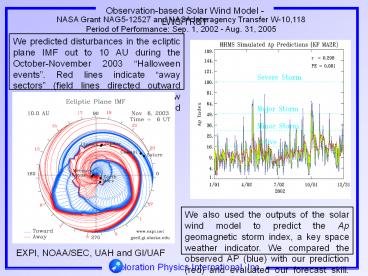NASA/LWS Observation-Based Solar Wind Model PowerPoint PPT Presentation
1 / 2
Title: NASA/LWS Observation-Based Solar Wind Model
1
NASA Grant NAG5-12527 and NASA Interagency
Transfer W-10,118Period of Performance Sep. 1,
2002 - Aug. 31, 2005
We predicted disturbances in the ecliptic plane
IMF out to 10 AU during the October-November 2003
Halloween events. Red lines indicate away
sectors (field lines directed outward from the
Sun) and blue lines show toward sectors
(inward-directed field lines).
We also used the outputs of the solar wind model
to predict the Ap geomagnetic storm index, a key
space weather indicator. We compared the observed
AP (blue) with our prediction (red) and evaluated
our forecast skill. Green is the difference.
EXPI, NOAA/SEC, UAH and GI/UAF
2
- Project Goal
- We want to understand the relationship between
the observed features on the Sun and the behavior
of the solar wind, the IMF, and the terrestrial
response over the 11-year solar activity cycle. - Significance
- The solar wind is a key link in the chain of
space weather extending from the Sun to the Earth
and beyond. Understanding it is critical to
predicting geomagnetic storms and space radiation
hazards. - What we are doing
- We are developing a Hybrid Kinematic/3D MHD solar
wind model (H3DM) and using it to study the
causes of IMF Bz over the solar activity cycle. - Key features of the system are it couples two
mature solar wind models - HAF (Hakamada-Akasofu-F
ry) and IGMV (Interplanetary Global Model,
Vectorized) it is driven by solar observations
and provides time-dependent solar wind
conditions at the locations of spacecraft in
interplanetary space. - What weve done so far
- Using only solar observations as inputs, we
simulated the propagation of interplanetary
shocks from the Sun to beyond 10 AU during the
Halloween event period (Oct.Nov., 2003). - We compared HAF model simulation results with
observations from spacecraft including Advanced
Composition Explorer (ACE), Mars Global Surveyor
(MGS), Ulysses, Cassini, Voyager 1 and 2. - The realistic simulations allowed us to interpret
spacecraft observations at Earth and Mars
following the Oct. 28, 2003, X17 solar event. - We evaluated IGMV-based predictions of the Ap
geomagnetic index for the years 1994, 1995 and
2002. - Scientific impact during the first two years of
the project - We published 22 papers in scientific journals (or
are in press), 25 were submitted or in
preparation, and we made 40 presentations at
organized national and international scientific
meetings.

